 |
| Derse Inc. launched a Challenge Convention microsite featuring campaign-related photos, YouTube videos, a Twitter feed, a blog, and an invitation for visitors to submit conventions they'd like to see challenged. |
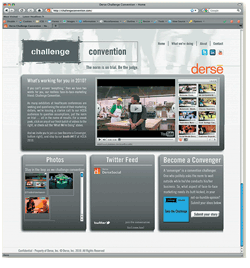 |

Twelve of the videos featured spoofs of conventions that were tested along with the proposed solutions that were ultimately rejected. Derse uploaded eight additional videos, featuring in-booth performances and activities, during the show.
|
 t's one thing to tell people to "think outside the box," but as Derse Inc. discovered at EXHIBITOR2010, an educational conference for exhibit- and event-marketing professionals, it's quite another to teach them how. Hell-bent on convincing attendees that the so-called conventions of face-to-face marketing aren't set in stone, Derse
set out to disprove some of the most commonly held beliefs. It wanted to challenge the marketing norms to prove not only that it could deliver results beyond conventional thinking,
but also that it could help exhibit managers do the same for their programs. And that's no small feat at a
show filled with attendees who have been taught that those same conventions were practically scribed on tablets and given to Moses at Mount Zion. t's one thing to tell people to "think outside the box," but as Derse Inc. discovered at EXHIBITOR2010, an educational conference for exhibit- and event-marketing professionals, it's quite another to teach them how. Hell-bent on convincing attendees that the so-called conventions of face-to-face marketing aren't set in stone, Derse
set out to disprove some of the most commonly held beliefs. It wanted to challenge the marketing norms to prove not only that it could deliver results beyond conventional thinking,
but also that it could help exhibit managers do the same for their programs. And that's no small feat at a
show filled with attendees who have been taught that those same conventions were practically scribed on tablets and given to Moses at Mount Zion.
To be successful, Derse knew it couldn't just launch a smear campaign against truths so commonly held that discarding them without explanation would cause a revolt on the show floor. Instead, the company opted for an educational experiment á la Sociology 101: Put face-to-face marketing norms on trial and see how the public reacts. But before it could test those norms, it had to identify them.
The Norm is on Trial
Derse began brainstorming its campaign for EXHIBITOR2010 about five months before the show. As a general rule, the company develops an exhibit-marketing campaign for EXHIBITOR Show in Las Vegas, which occurs
annually in March, and then continues that campaign for the rest of its trade shows throughout the year. "Any time we go into a campaign year, we look at what's happening in the attendee's world, and use that information to
develop new criteria for our face-to-face marketing approach," says Heather Rosenow, Derse's vice president of marketing. So to get into the world of the exhibit manager, Derse first looked to its own departmental disciplines to gain insight via informal
surveys about the concerns and challenges they were hearing from clients, and then turned to the clients themselves. "We also reviewed RFPs and business proposals to see what trends we could identify," Rosenow says. "What we found was that people seemed to be doing things a certain way because 'that's just the way it is.' That 'convention' mentality struck us as something worth exploring."
 |
To disprove the convention that direct mail is dead, Derse sent pre-registered attendees cardboard boxes containing five beans, a white plastic pot, potting soil, and planting instructions.

|
After poring over the proposals, RFPs, internal surveys, and anecdotal
information gathered during conversations with clients, Derse's marketing team dissected the entire exhibit-planning process, from the initial strategy to post-show follow-up and results, looking for conventions it could disprove. They came up with more than 100 conventions, and narrowed the list to 36, including everything from "direct mail is dead," to "you can't script aisle engagement." Derse then assigned each convention a random number and started brainstorming ways to challenge them via pre-, at-, and post-show engagements.
"We wanted to show attendees that by challenging these norms, they could potentially find smarter ways of doing things, and those ways might save them money, time, and effort, as well as improve their results," Rosenow
says. "That message is important now more than ever when marketing dollars
are under heavy scrutiny." Derse hoped to communicate to attendees that doing things a certain way "just because" was not only a detriment to the success of their programs, but also hindered creativity and ingenuity in an age when both are required to survive a down economy. Conventions in hand, Rosenow and her team began
developing an integrated exhibit program that would tackle the commonly held face-to-face marketing beliefs and identify fresh approaches to deliver efficiency, innovation, and measurable results.
Calling All Convengers
The first convention Derse set out to disprove was "B2B is too serious
for social media." The company developed and launched a microsite (www.ChallengeConvention.com) on its corporate website approximately two weeks before the show. The site featured a series of tongue-in-cheek YouTube clips portraying spoofs of conventions being tested along
with proposed solutions that were ultimately rejected.
Meant to illustrate a humorous approach to challenging convention, the clips hinted at the light-hearted attitude of the Challenge Convention campaign, and were designed to be "outtakes" versus actual solutions,
according to Rosenow. Eight new videos were uploaded throughout the show, including a handful of clips featuring scripted, in-booth performances and actors. However, a majority of the clips - 12, to be exact - were set in what Derse called its Challenge Convention Headquarters, and starred the company's employees in various roles.
 |
| Derse staff scattered orange Post-it Notes on trash cans ("Is it trashy to market on a garbage can?"), the floor ("Do your attendees ever look down?"), and anywhere else a Post-it could be placed throughout the convention center. |
 |

Staffers also placed orange urinal screens with the text, "Targeting the right customers?" in the venue's men's bathrooms.
|
Along with the videos, the microsite featured the text, "The norm is on trial. Be the judge," as well as the question "What's working for you in 2010?" and about two paragraphs explaining
the importance of questioning assumptions, including: "If you can't answer 'everything,' then we have two words for you, our restless face-to-face-marketing friend: Challenge Convention. As many exhibitors are seeking and questioning the value of their marketing dollars, we're issuing a clarion call to our EXHIBITOR2010 audience to question assumptions, put the norm on trial . all in the name of results." The text concluded with a call to action to become what Derse refers to as a "convenger," and an invite to visit booth #1545 at the show.
According to the site, "a 'convenger' is a convention challenger. One who politely asks the norm to wait outside
while he/she conducts his/her business." Visitors to the site became convengers by simply filling out a contact-information form and submitting a convention they would like to see challenged by Derse, or by sharing a convention they had successfully put to rest. Anyone who submitted a convention was entered in a drawing for a Flip camera, and the winners were announced via Twitter and e-mail.
 |
An accordion player serenaded attendees after the exhibit hall closed, challenging
the convention that "the customer
experience ends at 3:30 p.m."
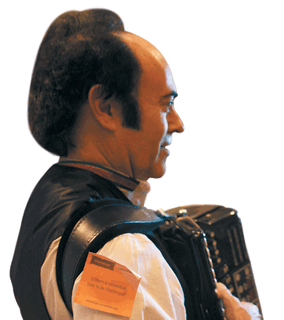
|
The microsite also housed a photo gallery, which featured staff-training pictures before the show. The gallery was updated throughout the show and eventually included photos of the exhibit, attendees interacting with Derse staff, and in-booth presentations.
Additional amenities on the microsite ranged from a convention-related blog written by Derse staff, to a show-specific Twitter feed along with instructions on how to use it for social-networking newbies. By using Twitter, YouTube, photo sharing, and a micro-site to promote its own campaign, Derse hoped attendees would realize that social media could indeed work for B2B marketing. One convention down - 35 to go.
Direct Mail Still Delivers
The next convention challenged was "direct mail is dead." At about the same time the microsite went live, Derse sent a pre-show mailer to each of the show's pre-registered attendees.
The mailer, a 4-by-4-inch white cardboard box with "convention #17" stamped on it, contained a small white plastic pot, a package of potting soil, five beans, and a lime-green tri-fold card printed on both sides. In addition to Derse's logo and web address, the card featured the same "convention #17" stamp found on the outside of the box, along with the text "Direct mail is dead they say? We say, plant this my friend." Text below that read: "Hey, we're as wired as the next face-to-face marketing juggernaut, but if you're looking to create an impression, a dimensional approach still rocks it in 2010," followed by instructions on how to plant the beans and care for the resulting sprouts.
The lime-green card also contained a blatant shout out for the microsite, informing recipients "you are holding just the first of thirty-six (give or take) conventions of face-to-face marketing
we plan to challenge during the course of your EXHIBITOR2010 experience. For the complete list visit www.ChallengeConvention.com, your single source for all things challenge-convention-ish." The card concluded with the following invitation: "We're putting the norm on trial at EXHIBITOR2010. You're the judge and jury. Visit us at booth #1545."
Though the pre-show mailer may have caused confusion for some recipients - it's not every day an exhibitor sends a bean plant - it also created intrigue and interest to the tune of 546 hits on the Challenge Convention microsite. But, as attendees would soon discover, Derse was just getting started.
 |
The white 20-by-30-foot exhibit was crowned with 112, 2-by-2-foot, white corrugated boxes made from recycled plastic. The lightweight structure reduced shipping and drayage costs.
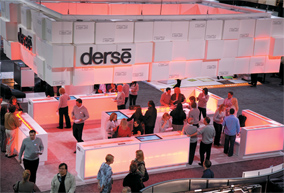
|
Show-Site Shenanigans
By the time the show started on March
14 at Mandalay Bay Convention
Center, the microsite had received 812
hits from 326 unique visitors (out of a
targeted 550 prospects), and Derse was prepared to disprove more face-to-face marketing norms - starting
with convention #29, "guerrilla
marketing can't make you think."
The purpose of challenging this convention, according to Rosenow, was to prove that the attendee experience doesn't have to stop when attendees leave the show floor.
To wit, this stage of the Challenge Convention campaign rolled out the first day of the conference, one day before the show hall even opened, in the form of orange Post-it Notes strategically located in the most unusual of places. The Post-its (which were void of Derse branding and the company's booth number in order to adhere to show-management rules regarding marketing off the show floor) contained the same Challenge
Convention logo found on the pre-show mailer and on the microsite.
Scattered throughout Mandalay Bay, the Post-its contained the Challenge Convention URL and one of five messages, reinforcing the campaign's theme, referencing the microsite, and
reminding attendees to think outside the box - or in this case, outside the booth. For example, to illustrate convention #36, "You can't learn
anything reading bathroom walls," Derse staff placed Post-its in the
bathroom stalls located near the conference rooms and the exhibit hall. Notes featured the text, "For a good
time challenging convention call 1-877-55DERSE." Those who dared to dial the number heard pre-recorded messages (there was a new message
every hour) about how Derse challenges convention, followed by a cheesy hummed tune for those dialers who needed a little more time to, well, tend to business. To prove nothing was too lowbrow when it comes to successful face-to-face marketing, Derse also placed orange urinal screens with the question, "Targeting the right customers?" in the men's bathrooms near the exhibit hall.
 |
| The counters featured color-changing LED lights that illuminated the white fabric-covered cabinets from the inside. That light then reflected off of the white plastic-box ceiling structure, creating the illusion that the exhibit was being lit from above. |
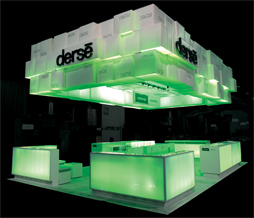 |
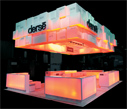
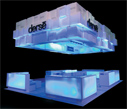
|
And lest attendees think that challenging convention is too complicated (convention #32), Derse staff pasted Post-it Notes on garbage cans ("Is it trashy to market on a garbage can?"), the floor ("Do your attendees ever look down?"), and almost anywhere else a Post-it could be placed ("Is there a convention to be challenged here?"). It also slapped a Post-it on an accordion player the company hired to play for attendees after the exhibit hall closed each day to challenge convention #33, "the customer
experience ends at 3:30 p.m."
Basically, Rosenow and her team wanted attendees to start thinking of every conceivable surface as a possible marketing opportunity in addition to the usual suspects, i.e., the trade show exhibit and all its trappings. But it's no surprise that Derse found conventions to be challenged there as well.
Exhibiting Inside the Box
When the show floor opened on March 15 and attendees made their way to Derse's 20-by-30-foot booth, they didn't see the typical exhibit accoutrements. Instead, they saw a large, 16-by-22-foot ceiling structure comprising 112, 2-by-2-foot, white corrugated plastic boxes, some of which featured a convention number,
such as "convention #28," in the same font and style as the gray Challenge Convention logo from the mailers, microsite, and orange Post-its.
 |
Staffers' sweaters reflected the same colored light that filled the exhibit space, so the uniform, in effect, became part of the brand and the environment.
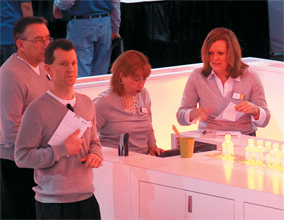
|
But the enormous structure, which featured the gray Derse logo on all four sides, wasn't just something pretty to look at - it alluded to the white cardboard box used in the pre-show mailer and challenged convention #92, "Green isn't cost efficient." Made of fire-rated recycled corrugated plastic to comply with fire regulations, the structure was lighter than conventional ceiling elements, helping Derse save on shipping and drayage costs. Plus, the structure took less labor - and ultimately, less time and money - to install.
Next, Derse's exhibit challenged convention #88, "all lighting must come from overhead." Again citing the cost and time associated with installing overhead rigging, Rosenow and her team came up with a budget-friendly solution for the booth's
illumination - uplighting housed in the exhibit's white counters. The counters, which lined the perimeter of the booth space save for four entry
points, featured color-changing LED
lights that illuminated the white fabric-covered cabinets from the inside. That light then reflected off of the white plastic-box ceiling structure, creating the illusion that the exhibit was being lit from above. The multicolored LEDs also illuminated an army
of eager booth staffers who were clad in light gray V-neck sweaters and black slacks - an outfit that challenged convention #44, "staff attire doesn't communicate," because, according to Rosenow, as the sweaters reflected the same colored light that filled the exhibit space, the staffers, in effect, became part of the brand and the surrounding environment.
The LED solution not only provided ample light for the exhibit; it also cut Derse's rigging costs by 50 percent and reduced the exhibit's installation time to two days versus the typical three days. What's more, the counters featured three, 32-inch touchscreens that booth staffers used to further explain the Challenge Convention theme to interested attendees, show off the company's portfolio, and qualify potential leads. In addition to the counters lining the space, a white counter island was placed in the center of the exhibit and served as another conversation area. And if attendees and staffers required a more subdued place to chat, a small meeting area in the back of the booth featured white banquettes and two cube-shaped side tables, continuing the booth's white-box aesthetic.
 |
Every hour the music changed and professional actors and singers appeared in the exhibit to perform one of six custom-scripted songs, each one illustrating a convention Derse has challenged.
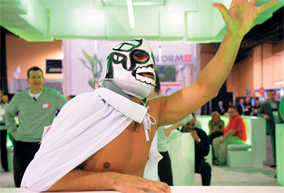
|
The result was a minimalist, yet sophisticated space. "The simplistic nature of the booth caught the attendee's eye and hopefully encouraged
them to question how such an impressive design could be made out of something as plain as plastic boxes," Rosenow says. "To further encourage them to explore the space, we used scent machines that emitted a pleasant,
light aroma, and used music to soothe people based on the time of day and how crowded the booth was." For example, upbeat music energized
attendees at the beginning of the day, while slower music played during peak times when booth traffic was typically heavier.
No Business Like Show Business
For those attendees that loitered in the aisle, unsure of whether to enter this serene oasis, Derse challenged convention #12, "you can't script aisle engagement." According to Rosenow, a majority of marketers believe that the first engagement along the aisle of a booth between a staffer and an attendee is the most challenging part of breaking the ice. To prove them wrong, Derse drafted several scripts. Based on a handful of different scenarios, each script included a part for the booth staffer and a part for the booth visitor.
Script in hand, a Derse staffer approached a visitor, talked briefly about the Challenge Convention campaign and exhibit, and invited him
or her to participate in the informal script reading. For example, one script called "Marry Me" began with the staffer asking, "So, how are you enjoying the show?" and "Would
you like to sign a proposal?" The
attendee answered with, "You haven't proposed anything yet," causing the staffer to get down on one knee and propose marriage. Flustered, the attendee then read the line, "This is all happening so fast. Maybe we should just start with a giveaway with a high-perceived value." The staffer then welcomed that attendee into the exhibit to learn more about his or her exhibit-marketing needs.
 |
| To prove that aisle engagement could be scripted, Derse drafted several scripts based on a handful of scenarios. Each script included a part for the booth staffer and a part for the booth visitor. |
But the scripts did more than challenge convention #12 and break the ice for the attendee who participated in the reading - the antics drew a crowd for the exhibit's main attraction, challenging convention #82, "in-booth presentations are predictable."
Every hour on the hour, one staffer walked around the booth holding up a sign that read "Challenge Convention," along with one of six conventions. After that staffer made his or her rounds (think ring girl at a boxing match), the music changed and professional actors and singers appeared in the exhibit to perform one of six custom-scripted songs. The performances, which featured song lyrics written by Derse's team of experiential-marketing designers, covered topics such as social media, booth design, budgeting, and buying a new exhibit property, among others. According to Rosenow, each song was written to address pre-identified conventions that, per the client feedback, resonated the most with the target audience. For example, the social-media song challenged convention #116 ("social media is scary"), and featured an amorous duet between a female attendee who had never tweeted before and a male staffer who teaches her how to use Twitter.
The performances included Derse's key messages, but the songs were also entertaining enough to continually
draw a crowd throughout the day. "The performances literally caught attendees and booth staff off guard," Rosenow says. "People gathered around, filled the aisles surrounding the booth during the skits, and returned to the booth multiple times throughout the show to catch the other performances, giving us the opportunity to engage repeat visitors." And in the off chance that an attendee missed a performance, Derse uploaded videos of all six
performances to its microsite.
In addition to challenging conventions with its exhibit design and
in-booth presentations, Derse also challenged convention with its giveaway. To disprove convention #50, "premiums aren't fashionable," Derse gave attendees a blue, branded T-shirt on which one of the following images was screen printed: a pen, a Post-it Note, a flash drive, or a show bag. "We created a double-entendre with this convention by turning the giveaway into a fashionable item - a T-
 |
Taking a literal approach, Derse distributed branded T-shirts on which an image of one of the following giveaways was screen-printed: a pen, a Post-it Note, a flash drive, or a show bag.
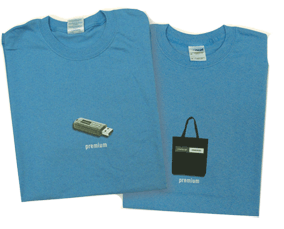
|
shirt," Rosenow says. "Interestingly, the most popular T-shirts were the ones with show bags on them."
Something to Talk About
That tongue-in-cheek approach to exhibit marketing continued with the post-show mailer. About a week after the show, Derse sent each qualified booth visitor an "Officially Licensed Challenge Convention Test Kit." The kit contained only a pen and a notepad made of post-consumer waste products on which recipients could jot down their own ideas on how to challenge convention. The mailer also included an invitation to visit the microsite and share feedback on the success (or failure) of the campaign. "We wanted to continue the dialogue with attendees and show them that we're here to listen, and ultimately, to help them optimize the effectiveness of their programs and increase their measurable results," Rosenow says. And given the success of its campaign, Derse knows a thing or two about measurable results.
From bean plants and Post-it Notes to urinal screens and catchy tunes, the company's Challenge Convention campaign ran the unconventional gamut - and attendees appreciated it. The microsite continued to attract hundreds of visitors in the two weeks after the show, and the company is now responding to four new RFPs and anticipates four more. Furthermore, Derse exceeded all of its goals for the campaign, including surpassing its goal for unique microsite visitors and new prospects (by 42 percent and 15 percent, respectively), and gaining 22 percent more Twitter followers than it had hoped.
By executing a campaign that challenged the same conventions on which the face-to-face-marketing industry was built, Derse not only broke all the rules - it rewrote them. E
|






 t's one thing to tell people to "think outside the box," but as Derse Inc. discovered at EXHIBITOR2010, an educational conference for exhibit- and event-marketing professionals, it's quite another to teach them how. Hell-bent on convincing attendees that the so-called conventions of face-to-face marketing aren't set in stone, Derse
set out to disprove some of the most commonly held beliefs. It wanted to challenge the marketing norms to prove not only that it could deliver results beyond conventional thinking,
but also that it could help exhibit managers do the same for their programs. And that's no small feat at a
show filled with attendees who have been taught that those same conventions were practically scribed on tablets and given to Moses at Mount Zion.
t's one thing to tell people to "think outside the box," but as Derse Inc. discovered at EXHIBITOR2010, an educational conference for exhibit- and event-marketing professionals, it's quite another to teach them how. Hell-bent on convincing attendees that the so-called conventions of face-to-face marketing aren't set in stone, Derse
set out to disprove some of the most commonly held beliefs. It wanted to challenge the marketing norms to prove not only that it could deliver results beyond conventional thinking,
but also that it could help exhibit managers do the same for their programs. And that's no small feat at a
show filled with attendees who have been taught that those same conventions were practically scribed on tablets and given to Moses at Mount Zion.






















